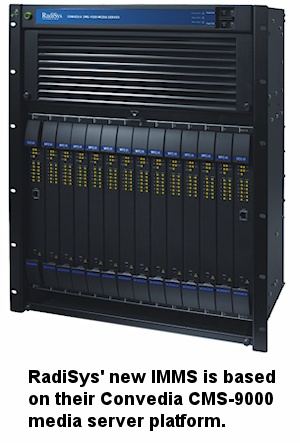Past Entry of Zippy's Telecom Blog
More Previous Columns
February 19, 2010
RadiSys Introduces the Integrated Mobile Media Server for Mobile Service Providers
 On February 8, 2010, RadiSys® Corporation (NASDAQ: RSYS), a global provider of application ready-software and hardware platforms for use in the communications, multi-media, mil/aero and medical markets, announced the Integrated Mobile Media Server (IMMS), which is designed to enhance Mobile Service Providers’ (MSPs) ability to grow new revenues from the sudden increase in 3G mobile video services and emerging 4G Long Term Evolution (LTE) deployments. The IMMS provides an optimized video delivery solution across diverse networks: RadiSys’ implementation of 3G-324M support overcomes the obstructions posed by expensive 3G-324M video gateway solutions that are up to 10x the cost of traditional VoIP voice gateways. IMMS essentially eliminates the need for 3G-324M video gateways, and terminates 3G-324M video circuits using Telecom Equipment Manufacturers’ (TEMs) existing VoIP voice gateway products. Additionally, the solution transfers the 324M protocol processing inside the media server, consolidating network elements and simplifying network management. By reducing the number of network elements in the call path, the IMMS also improves video quality while reducing call path delay.
On February 8, 2010, RadiSys® Corporation (NASDAQ: RSYS), a global provider of application ready-software and hardware platforms for use in the communications, multi-media, mil/aero and medical markets, announced the Integrated Mobile Media Server (IMMS), which is designed to enhance Mobile Service Providers’ (MSPs) ability to grow new revenues from the sudden increase in 3G mobile video services and emerging 4G Long Term Evolution (LTE) deployments. The IMMS provides an optimized video delivery solution across diverse networks: RadiSys’ implementation of 3G-324M support overcomes the obstructions posed by expensive 3G-324M video gateway solutions that are up to 10x the cost of traditional VoIP voice gateways. IMMS essentially eliminates the need for 3G-324M video gateways, and terminates 3G-324M video circuits using Telecom Equipment Manufacturers’ (TEMs) existing VoIP voice gateway products. Additionally, the solution transfers the 324M protocol processing inside the media server, consolidating network elements and simplifying network management. By reducing the number of network elements in the call path, the IMMS also improves video quality while reducing call path delay.
To further probe the many capabilities of the IMMS, Yours Truly was granted an interview by RadiSys’ Ray Adensamer, senior manager, product marketing and Peter Birkwood, director of product management.
Richard Grigonis: I see you have a new packet-based service delivery system to handle advanced wireless for service providers.
Ray Adensamer: It’s an expansion of our media server program, but much broader in scope and more targeted to the mobile space. On February 8, 2010, we launched a new product initiative called the Integrated Mobile Media Server, or IMMS. We’re positioning this as a product to help mobile service providers with the cost-efficient generation of 3G revenues beyond flat-rate data plans. I’ll further explain what I mean by the revenue problem faced by operators in the emerging 3G market and how IMMS helps to fix that.
We think we can achieve all this via the integration of certain functions for mass market cost efficiencies, and during today’s discussion we will discuss how, in this first IMMS release, we got an integrated 3G-324M mobile circuit video support, and how we were able to deliver two-way conversational services. This is what the media server is very good at doing today, and it’s what we’ve already been doing in the mobile space for the past few years, but we’re also going to be adding features both in this initial release and, over time, to enhance one-way video streaming services—so a provider can monetize those services rather than just letting them just go over the top through a data plan.
Richard Grigonis: So what exactly is the target market?
Ray Adensamer: Our target market is obviously the mobile operators but our channel-to-market would be through tier-1 mobile infrastructure vendors. We already have a design win with one of the big two Chinese TEMs [Telecom Equipment Manufacturers]. They are integrating our media server into their product, and we’re hoping to sign up a few more vendors like that.
 In any case, the first release that we’re announcing is based on the RadiSys Convedia CMS-9000 Media Server, which is already delivering a IMS MRF type of function [the MRF, or Media Resource Function within the IMS delivers media services], but the new thing we’ve added to this release is the integrated 3G-324M video support. The technical innovation behind the IMMS release is certainly important, but the bottom line is that there’s a high cost in roll-outs today of the standalone network element called the 3G-324M video gateway. By our alternative approach that uses a conventional economic voice gateway, combined with a protocol processing that we do now in our box, we know we can reduce the price-per-port by at least 50 percent. The bottom line benefit of lowering the price-per-port is that we’re making it more economical to roll out the advanced video services for mass market deployments, and it positions the MSP [Mobile Services Provider] to have a cost-efficient infrastructure so it can make money beyond the data plan it offers.
In any case, the first release that we’re announcing is based on the RadiSys Convedia CMS-9000 Media Server, which is already delivering a IMS MRF type of function [the MRF, or Media Resource Function within the IMS delivers media services], but the new thing we’ve added to this release is the integrated 3G-324M video support. The technical innovation behind the IMMS release is certainly important, but the bottom line is that there’s a high cost in roll-outs today of the standalone network element called the 3G-324M video gateway. By our alternative approach that uses a conventional economic voice gateway, combined with a protocol processing that we do now in our box, we know we can reduce the price-per-port by at least 50 percent. The bottom line benefit of lowering the price-per-port is that we’re making it more economical to roll out the advanced video services for mass market deployments, and it positions the MSP [Mobile Services Provider] to have a cost-efficient infrastructure so it can make money beyond the data plan it offers.
Richard Grigonis: What are the revenue challenges with 3G packet services? How do you solve them?
Ray Adensamer: As you know, with respect to a 3G network, the new 3G handsets that are emerging, such as the iPhone and the Google Android, are very data-hungry devices that are generating large traffic flows, specifically large one-way video traffic flows from third-party content providers, such as Hulu, YouTube and companies like that, going through these data packet services to a 3G device. So, at the highest level, the question becomes, who’s benefitting from this? The obvious beneficiaries would be the handset vendors and the content providers, but the mobile services provider here in the middle are really constrained to provide a bit pipe: they’re basically providing undifferentiated, flat-rate packet-access service that isn’t really taking advantage of these broader trends in how 3G mobile users are consuming and communicating. In fact, what they are incurring are huge costs. You may have heard the statistic that in the AT&T Wireless network, three percent of the handsets are generating 40 percent of the traffic. We at RadiSys feel that we have a solution to help mobile service providers by giving them the tools and cost-efficient infrastructure so that they can claim a bigger share of this revenue opportunity.
A good first step is to start offering personalized conversational two-way audio/video mobile services, such as color ring back tones, unified messaging, interactive voice and video response, conferencing and so forth. To deliver those types of services with today’s technologies, each service typically has its own ‘silo,’ which means that each service has its own platform, TDM ports, application logic and media processing, which makes it resemble the classic incremental, service-node approach to adding service-by-service-by-service. If a mobile operator follows such an approach, then each additional application makes the overall architecture difficult to manage and scale. What you end up with is a complex operating environment, a high price per port, which constrains the operator’s ability price these cool new personalized features in a way that achieves mass market adoption.
Richard Grigonis: Your Integrated Mobile Media Server [IMMS] server solves all these problems?
Ray Adensamer: The whole vision of the IMMS is to create a cost-efficient, service delivery system that can help mobile operators generate these 3G revenues beyond those of typical flat-rate data plans. We achieve this through functional integration, which involves the 3G-324M feature in our first release. The IMMS can deliver the two-way conversational services that I mentioned earlier, and it does that using a common platform with high scalability, exposed via open protocols to app servers and content servers and things like that.
We also have some interesting ideas to enhance the one-way video streaming service. Rather than just having streaming service go through and be subject to the data plans, we can instead route those video streams to our box, and then we can enhance it. In this first IMMS release, we’re doing things such as text overlays, so we can support text advertising messages or branding messages. In the future we’re thinking of bandwidth control and video transrating and transcoding and things like that.
IMMS Release 1.0 Highlights
Ray Adensamer: RadiSys acquired Convedia in September 2006. We continue to invest in the product line that is showcased by the RadiSys Convedia CMS-9000 Media Server. We continued to be recognized as the Number 1 supplier for third-party media servers.
As I said previously, it’s an industry-leading IP media processing platform [IMS MRF, or IP Multimedia Subsystem Media Resource Function delivering services] that has extensive audio, video and speech processing features for many 3G applications such as audio/video Ring Back Tones [RBTs], Interactive Voice and Video Response [IVVR] and multimedia conferencing. It supports such mobile speech codecs as the Adaptive Multi-Rate [AMR] and Enhanced Variable Rate Codec [EVRC], as well as video codecs such as H.263 and H.264. This new IMS Release 1.0 is available as a software upgrade to the existing CMS-9000 deployments. Indeed, software plays an important role in our standards-based integration with application servers and storage devices. We support Session Initiation Protocol [SIP] and XML-based scripting interface for 3G/IMS application control, and an NFS/HTTP interface to content storage devices. We have an integrated RTSP client and interface for one-way streaming servers that allows IMMS to receive RTSP streaming content, including live video. This means that you can have an upstream RTSP server that can provide pre-recorded or live video that travels into our IMMS box, and there we can ‘enhance’ the video streams before forwarding them to the 3G endpoint as a bidirectional RTP media stream.
Finally we have added the integrated 3G-324 video support, which eliminates the need for standalone 3G-324M video gateways in the operator’s 3G network architecture, and it allows our IMMS to seamlessly support both IP packet-based and 3G-324M circuit switch-based endpoints and services.
As we developed this product and have prioritized its features, Peter Birkwood, our director of product management at RadiSys, did an analysis of mobile service providers in an attempt to determine how those MSPs are actually generating revenues, and how our products mapped to those activities. Our CMS-9000 provides IP media processing available today in many mobile networks, but its usage is somewhat constrained to enhanced services, such as multimedia conferencing, ringback tones, or unified messaging. With IMMS, and the new integrated 3G-324M solution, we’ve introduced significant cost savings for each and every 3G-324M call – even basic point-to-point calls, which are a much larger revenue stream of a mobile service provider.
We have plans for incorporating various other features into the IMMS, such as achieving interactive messaging and thus generating social networking revenues; having the IMMS enable operators to garner basic packet services revenue via generic data plans used primarily for Internet access; generating enhanced packet services subscription revenues for content and entertainment; delivering presence/personalization-based “Mobilized Internet” services revenues; e-commerce and credit services revenues; and ways of generating corporate/enterprise services revenues.
The takeaway here is that the whole IMMS product is really designed to offer bundled solutions—be they RadiSys products or RadiSys products with our partners—to address these many types of revenue streams in a cohesive way.
And now I’ll let Peter Birkwood, our director of product management, add some of his own comments…
 The Bundled IMMS Model vs. Media Server Model
The Bundled IMMS Model vs. Media Server Model
Peter Birkwood: We at RadiSys have been highly influenced by the business models and service experimentation that occurred over the past nine years in Japan, particularly in those areas which have not been subject to innovation in North America. I’ve taken a very close look at these various models. The reason we’ve gone forward with our ‘bundled IMMS model’ is because the mobile technologies are a mixture of low-tech and high-tech. For example, SMS [Short Messaging Service] is considered ‘low-tech’. It has been around for 20 years. It’s basically the modern incarnation of an old paging technology, but it generates over $100 billion USD by itself for mobile service providers.
When we looked at this we said, “We really need to be able to mix varieties of technologies that exist in the mobile space.” That actually is a bit of an innovation in how to put these types of systems together and I don’t think there’s anything presently on the market quite like our IMMS platform. IMMS is unique. With it you’re able to start doing mash-ups between various revenue streams, and we really are ‘following the money’ when it comes to identifying and enhancing those revenue streams with this IMMS approach.
Advanced Services Galore
Ray Adensamer: Take one IMMS service example: a video ring back media service. Ring Back Tones are audio sounds head by a calling party. Today, we’re all familiar with Color Ring Back Tone (CRBT) services, which allow the called party to customize their ring back audio: I call you, and if you’re not there and I’m waiting for the call to connect, you get a specific audio clip to play to the caller rather than the typical boring ‘ring-ring’ sound. It could be music, or a personalized greeting, etc. Now, a Video Ring Back Media Service is same concept, but using a custom video clip instead. So, if you have a 3G video-enabled phone, when I call you, you can send me a video ring back clip.
Then there’s 3G mobile video conferencing. Video conferencing itself is no longer novel, but the way we do it is unique. Rather than calling upon a video Multi-point Control Unit (MCU) or bridge-type of product, which is usually involves a proprietary integration of hardware and the application logic, we are true to the standards of an IMS architecture. We are the MRF. We do the video media mixing, and we expose that through a SIP interface for application or control functions. With this service we support two different modes via the standard-based interface: One is continuous presence, involving multi-pane displays and providing a more immersive experience. This would be the more traditional 2x2 or what I call “The Brady Bunch Display” where you have, say, four panes of active video.
But that particular type of video conference obviously doesn’t work well on a little 3G handset because the screen is quite small. So what we do instead is to actively promote the idea of voice-activated video switching, so you could have, say, four participants with an active speaker occupying the screen, and two others have video-enabled calls, Participants can see the active speaker, and perhaps the fourth conference participant has a traditional non-video-enabled 2G mobile phone, so he or she can only hear the active speaker. It demonstrates how our platform can do these types of ‘mixing’.
With our Chinese partner we’ve pursued the service called IVVR [Interactive Voice and Video Response]. It derives from the notion of a traditional audio IVR application, but now anytime you play a prompt or a message you see a video clip instead of hearing an audio clip. IVVR is applicable to many different applications, such as customer service, multimedia service demos, surveillance applications, televoting in mobile TV and even inserting playback controls for video streams—like pause, fast forward and rewind controls.
IVVR can also incorporate “video text overlay,” and we’re starting to show off what we can do in that area too. We support multiple languages and different text rendering features—such as size, color and font.
Even in the world of audio, we are supporting advanced functions, such as Automatic Speech Recognition [ASR], so that rather than type a digit on the keypad, you just utter a command.
Again, all of these capabilities are exposed via a SIP and XML-based interface. That’s why it’s so cool and powerful—it can be reused by many different applications and so we’re not constraining the creativity of the application developer.
Finally, another major IMMS service example is video advertising. Again, it’s just a matter of taking some basic capabilities and using video advertising as a ring back mechanism or showing video advertising at the beginning of a video call or other requested video content. Video advertising can be thus be leveraged in various call flow and service models. I was recently on a business trip in India where they weren’t offering video ring backs, but audio ring backs. My colleague made a call with his cell phone and he was willing to put up with 15 seconds of audio advertising before his call actually connected through. The reason why he was willing to do that was because the pricing plan is lower thanks to the advertising. So video advertising allows mobile operators to generate additional revenues from advertisers and at the same time it subsidizes operating costs, which allows operators to lower video service pricing to consumers. The resulting lower pricing attracts more price-sensitive subscribers.
Richard Grigonis: It appears that the IMMS can open up all sorts of new sources of revenue for mobile service providers.
Ray Adensamer: Essentially, IMMS shifts the point of service monetization into the MSP’s control, especially for one-way streaming content that, in our opinion, is just completely bypassing the mobile service providers. We’re trying to give them mechanisms to get that control back.
To sum up, the RadiSys IMMS reduces costs for mass market 3G deployments: It consolidates disparate service processing equipment into a single, cost-efficient carrier-class network element; integrates both 3G circuit-based and packet-based mobile video networks such as 4G / LTE; integrates both RTSP streaming and interactive RTP services; delivers interoperability between various mobile access technologies, codecs and file formats and enables savings of at least 50 percent capex and ongoing opex savings for mobile operators employing a 3G-324M video service infrastructure.
Furthermore, as we’ve said, the IMMS enhances the mobile operator’s ability to generate 3G revenues. Today’s 3G services are dominated by one-way video streaming of Internet content. The problem is that mobile operator revenues from these trends is constrained to flat-rate data plans, but the enhanced two-way conversational video services made possible by our IMMS provide increased revenues. We not only handle two-way conversational video services but we enhance one-way streams as well. In today’s telecom world where infrastructure solutions are complex, and not optimized for mass market rollouts, RadiSys IMMS positions mobile operators to do just that and generate new service revenues.
Richard Grigonis: So it’s just a matter of letting mobile services operators know that you’re well-positioned to help them.
Ray Adensamer: We are already recognized by companies such as Infonetics as the number one supplier of IP media processing technologies and products. We already have many of the features you need for these two-way interactive services and through the addition of the 324M feature, it extends video into the mobile space.
Meanwhile, my RadiSys colleagues in our Hillsboro, Oregon location are leading a product program which has resulted in our becoming the number one supplier for AdvancedTCA [ATCA] product platforms. Our Promentum ATCA platforms, a family of chassis, CPU blades, DSP blades and Switch blades, are increasingly being selected in some of these mobile infrastructure products, going into LTE networks and things such as that. That’s because Promentum ATCA platforms are designed for highly scalable, cost-efficient, high-reliability telco operations.
As for our business model, it’s built on partnering with leading telecom solution vendors, engaged with standards-based activities. For example, one of the standards that we’re promoting is the IETF Media Server Markup Language [MSML], which has just become RFC 5707. The MSML can be used to control and invoke many different types of services on IP media servers. Clients can use it to define how multimedia sessions interact on a media server and to apply services to individuals or groups of users. MSML can be used, for example, to control media server conferencing features, such as video layout and audio mixing, creating sidebar conferences or personal mixes and setting the properties of media streams. As well, clients can use MSML to define media processing dialogs, which may be used as parts of application interactions with users or conferences.
So we’re getting industry recognition for our standards work.
And of course our RadiSys Alliance Partner Program [RAPP] encompasses a large ecosystem of telecom solution vendors which have integrated RadiSys products into their solutions. Our integrated solution offerings with our partners can accelerate an MSP’s ability to generate new, differentiated revenues, which is of course of paramount importance to operators and providers everywhere.
Richard Grigonis: The IMMS looks to be a tremendous platform for mobile operators. I’ll be curious to see what other hoops it will jumping through in the future.
